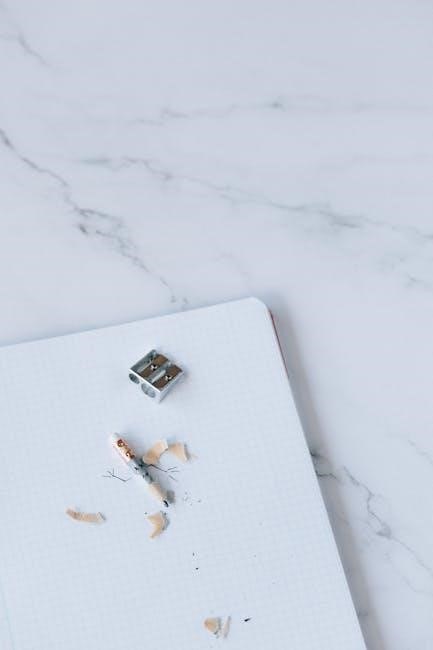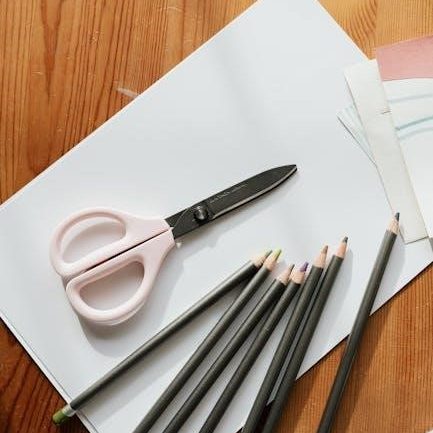The Lansky Sharpener is a top choice for knife enthusiasts, offering ease of use and precision. It features multiple sharpening angles and convenient components, ensuring razor-sharp results effortlessly while avoiding common sharpening errors. Ideal for all skill levels, it’s a must-have tool for maintaining sharp blades.
1.1 What is a Lansky Sharpener?
A Lansky Sharpener is a controlled-angle sharpening system designed for precision and ease. It features adjustable angles, sharpening stones, and a clamp to secure the knife. Perfect for beginners and experts, it ensures consistent results and is versatile for various blade types, including serrated knives. Its durability and portability make it a favorite among knife enthusiasts worldwide.
1.2 Importance of Using a Lansky Sharpener
Using a Lansky Sharpener ensures precise control over sharpening angles, minimizing errors. It restores dull knives to razor-sharp condition effortlessly, extending blade life. Its controlled-angle system is ideal for beginners and experts, providing consistent results. Regular use maintains knife quality, making it an essential tool for anyone needing reliable sharpening performance.
Understanding the Components of Lansky Sharpener
The Lansky Sharpener features a clamp, sharpening stones, and an angle guide. These components work together to simplify sharpening, ensuring precise control and consistent results for any knife blade.
2.1 The Clamp and Its Function
The clamp is a critical component of the Lansky Sharpener, securely holding the knife at the desired angle. Its design ensures stability, allowing precise control during sharpening. However, for larger knives, positioning can be challenging due to the clamp’s limited depth. Proper alignment is essential for effective sharpening and maintaining blade integrity.
2.2 Sharpening Stones and Their Types
Lansky Sharpeners feature high-quality sharpening stones, including Diamond, Ceramic, and Arkansas types. Diamond stones are coarse and ideal for repairing damaged edges, while Ceramic stones polish blades to a fine edge. Arkansas stones, natural and versatile, are perfect for everyday sharpening. Each stone type ensures precise edge refinement, catering to different knife maintenance needs.
2.3 Angle Guide and Its Role
The Lansky Sharpener’s angle guide is crucial for maintaining consistent sharpening angles, ensuring precise control. It allows users to choose from preset angles like 17°, 20°, 25°, and 30°, tailored for specific blade types. This feature minimizes human error, enabling novice and experienced users alike to achieve professional-level sharpness with ease and consistency across all sharpening sessions.

Selecting the Right Sharpening Angle
Selecting the right angle is crucial for effective sharpening. Common angles like 17°, 20°, 25°, and 30° cater to different blade types. Lansky’s system helps avoid errors, ensuring precise results.
3.1 Common Sharpening Angles (17°, 20°, 25°, 30°)
The Lansky Sharpener offers four primary sharpening angles: 17°, 20°, 25°, and 30°. The 17° angle is ideal for razor-sharp edges, while 20° suits high-quality knives. The 25° angle is versatile for everyday use, and 30° provides durability for heavy-duty blades. These angles ensure precision and adaptability for various knife types and uses.
3.2 Choosing the Best Angle for Your Knife
Selecting the right angle depends on your knife’s intended use. A 17° angle is best for razor-sharp edges, while 20° suits high-quality blades. For everyday knives, 25° offers versatility, and 30° provides durability for heavy-duty tasks. Match the angle to your knife’s purpose for optimal results and a long-lasting edge.
Preparing Your Knife for Sharpening
Inspect the blade for damage, position it securely in the clamp, and set the correct sharpening angle. Proper preparation ensures safe and effective sharpening results.
4.1 Inspecting the Blade
Before sharpening, inspect the blade for chips, cracks, or rust. Ensure the edge is free of debris and straight. Noting any damage helps target sharpening efforts effectively for optimal results and blade longevity. A thorough inspection ensures a safer, more efficient sharpening process with the Lansky system.
4.2 Positioning the Knife in the Clamp
Position the knife in the clamp by aligning the edge with the guide or mark on the clamp. Ensure the blade is secure and adjust the clamp to fit the knife’s length. For straight blades, the bevel should face upwards. Use a piece of paper to draw a line along the edge and align it with the clamp’s reference mark. Tighten the clamp firmly to prevent movement during sharpening. For serrated blades, check if a different setting or adapter is needed. Once positioned, use the angle guide to set the correct sharpening angle for consistent results.
4.3 Setting the Correct Angle
Select the appropriate angle using the Lansky Sharpener’s angle guide, typically 20° for kitchen knives. Place the sharpening stone into the corresponding angle hole. Align the stone with the knife’s edge, ensuring it matches the desired angle. Use the guide to maintain consistency and prevent errors. This setup ensures precise sharpening and a razor-sharp edge every time.

Step-by-Step Sharpening Instructions
Start by placing the sharpening rods in the desired angle holes. Follow the guide to maintain precise strokes, ensuring consistent sharpening. Begin at 20° for most knives, then adjust as needed for the perfect edge.
5.1 Clamping the Knife
Properly clamping the knife is essential for precise sharpening. Place the blade in the clamp, ensuring the edge aligns with the guide. Use a marker or paper to mark the edge for alignment. Secure the knife firmly but avoid over-tightening, which could damage the blade. This setup ensures stability and accurate angle control during sharpening.
5.2 Using the Sharpening Stones
Start with the coarsest sharpening stone to establish the edge. Hold the stone firmly and draw it across the blade, maintaining the set angle. Repeat strokes evenly, checking progress with each pass. Progress to finer stones for polishing, ensuring a razor-sharp finish. Use light pressure and consistent motion for optimal results and blade longevity.
5.3 Maintaining the Correct Angle
Maintain the correct angle by aligning the sharpening stone with the angle guide. Lightly hold the stone against the blade, ensuring consistent contact. Use smooth, controlled strokes, moving from heel to tip. Avoid applying too much pressure, as this can damage the edge. The angle guide ensures precision, making it easier to achieve a sharp, even edge every time.
5.4 Checking the Sharpness
To check the sharpness, carefully run your thumb (with light pressure) along the blade’s edge. A sharp knife will feel crisp and bite into your thumb. Alternatively, slice through a piece of paper; a sharp knife will cut cleanly and effortlessly. Regularly checking ensures the blade meets your desired sharpness and prevents over-sharpening.
5.5 Final Polishing and Cleanup
After sharpening, use a fine-grit stone or ceramic hone for final polishing. Wipe the blade clean with a soft cloth to remove metal particles. Inspect the sharpener and clean any residue with mild soap and water. Proper cleanup ensures the Lansky Sharpener remains in excellent condition for future use and maintains hygiene standards.
Maintenance and Care of the Lansky Sharpener
Regularly clean sharpening stones with mild soap and water. Dry thoroughly after cleaning. Store the sharpener in a dry place to maintain its performance and longevity.
6.1 Cleaning the Sharpening Stones
Clean sharpening stones with mild soap and water to remove metal particles and debris. Avoid harsh chemicals or abrasive cleaners, as they may damage the stones. Dry thoroughly after cleaning to prevent rust or deterioration. Regular maintenance ensures optimal performance and extends the life of your Lansky Sharpener.
6.2 Storing the Sharpener
Store the Lansky Sharpener in a dry, cool place to prevent rust and damage. After cleaning, ensure all components are completely dry. Use the original packaging or a protective case to keep parts organized and secure. Proper storage maintains the sharpener’s condition, ensuring longevity and readiness for future use. Always keep it out of children’s reach.

Tips for Optimal Sharpening
Maintain the correct angle, use light strokes, and avoid applying too much pressure. Consistency and patience are key to achieving the best sharpening results.
7.1 Avoiding Common Mistakes
Common mistakes include using the wrong sharpening angle, improper knife positioning, and applying too much pressure. To avoid these, ensure the blade is securely clamped, select the correct angle for your knife type, and use light, consistent strokes. This prevents damage and ensures a precise, sharp edge every time.
7.2 Using the Right Technique
Using the right technique ensures optimal sharpening results. Maintain controlled, light strokes, aligning the blade at the correct angle. Keep the knife firmly clamped and use consistent pressure to avoid uneven sharpening. This method prevents damage and achieves a sharp, even edge efficiently, making the most of your Lansky Sharpener’s features.

Troubleshooting Common Issues
This section addresses common problems users face while sharpening. Issues like improper sharpening or blade damage are discussed, providing solutions such as angle adjustment and alignment checks.
8.1 Knife Not Sharpening Properly
If your knife isn’t sharpening properly, check the angle setting and alignment. Ensure the blade is securely clamped and the sharpening stone is used correctly. Incorrect angle placement or uneven pressure can prevent effective sharpening. Adjust the clamp and angle guide, and verify that the stone is suitable for your knife type. Repeat strokes evenly for consistent results.
8.2 Damage to the Blade
Damage to the blade can occur from excessive pressure or incorrect sharpening angles. Inspect the knife for nicks or uneven edges; Light, controlled strokes and proper angle alignment are essential to prevent damage. If damage occurs, start with a coarse stone to reshape the edge, then progress to finer stones for polishing and restoration.
Exploring Different Lansky Sharpening Kits
Lansky offers various sharpening kits, including Deluxe 5 Stone, Diamond Stone, and Arkansas Stone systems. Each kit provides unique features tailored to specific sharpening needs, ensuring durability and precision for optimal results.
9.1 Deluxe 5 Stone System
The Deluxe 5 Stone System by Lansky features five high-quality sharpening stones, ranging from coarse to fine grit. Designed for precision, it includes 70, 120, 600, 1500, and 3000 grit stones. This versatile kit is ideal for sharpening various knife types, ensuring a razor-sharp edge with minimal effort. Perfect for both beginners and experienced users, it offers durability and consistent results.
9.2 Diamond Stone System
The Lansky Diamond Stone System offers a durable and efficient sharpening solution with diamond-coated stones. Featuring 600 and 1500 grit options, it quickly sharpens and polishes blades. The diamond stones are long-lasting and require no oil, making maintenance easy. Ideal for professionals and home users, this system ensures a sharp, precise edge with minimal effort and exceptional results.
9.3 Arkansas Stone System
The Lansky Arkansas Stone System is a premium choice for knife sharpening, offering natural novaculite stones known for their superior sharpening qualities. These stones are available in various grits, from coarse to fine, ensuring a precise edge. The system is durable and long-lasting, making it ideal for both professional and at-home use, providing excellent results for all blade types.
Safety Precautions
Always handle sharp objects with care, wearing gloves if needed. Store the sharpener securely to prevent accidental injuries. Keep out of reach of children and ensure stable placement while sharpening to avoid mishaps.
10.1 Handling Sharp Objects Safely
Always wear protective gloves to prevent cuts. Ensure the knife is securely clamped before sharpening. Keep fingers away from the blade’s edge. Avoid sharpening near children or pets. Maintain a stable work surface and avoid distractions to minimize accidents while handling sharp tools.
10.2 Storing the Sharpener
Store the Lansky Sharpener in a dry, clean environment to prevent rust and damage. Use a protective case or pouch to safeguard the components. Keep it away from children and pets to ensure safety. Regularly clean and maintain the sharpener before storage to prolong its effectiveness and longevity.
The Lansky Sharpener is a reliable tool for achieving razor-sharp blades. By following the instructions and practicing, you can master knife sharpening and extend your knife’s lifespan effectively.
11.1 Summary of Key Steps
Using a Lansky Sharpener involves securing the knife, selecting the right angle, and stroking the blade across the stone. Regular maintenance ensures optimal performance. Practice makes perfect, so sharpening becomes second nature, keeping your blades sharp and ready for any task at hand with minimal effort and maximum efficiency always.
11.2 Encouragement to Practice
Sharpening with a Lansky Sharpener is a skill that improves with practice. Embrace the process, and soon you’ll achieve perfectly sharp blades every time. The satisfaction of a razor-sharp knife is rewarding, making every task easier. Keep practicing, and you’ll master the technique, ensuring your knives stay in top condition for years to come.




